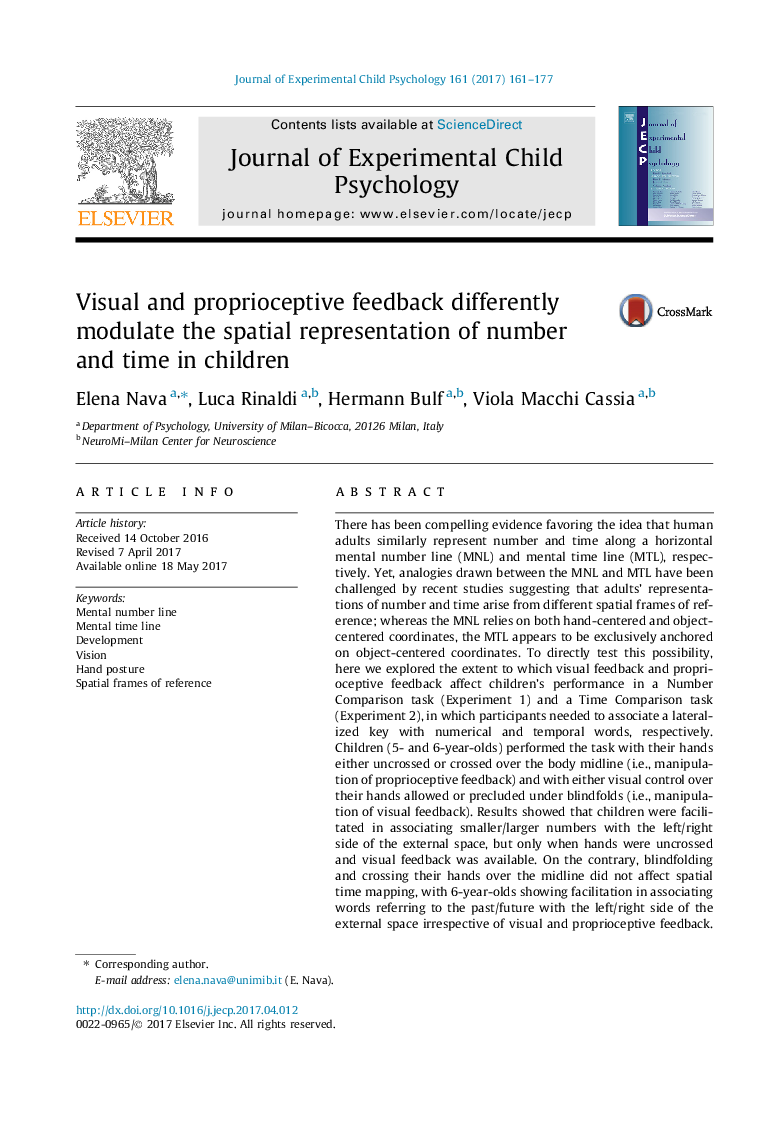| کد مقاله | کد نشریه | سال انتشار | مقاله انگلیسی | نسخه تمام متن |
|---|---|---|---|---|
| 5039916 | 1473451 | 2017 | 17 صفحه PDF | دانلود رایگان |

- Six-year-old children automatically access spatial representations when processing time, as well as numbers.
- Representation of time concepts is weak but already spatialized at 5Â years.
- Children associate smaller numbers/past events to the left side of space and larger numbers/future events to the right side.
- Number-space mapping is influenced by both visual and proprioceptive feedback, whereas time-space mapping is not.
- The mental representations of number and time are anchored on different spatial frames of reference.
There has been compelling evidence favoring the idea that human adults similarly represent number and time along a horizontal mental number line (MNL) and mental time line (MTL), respectively. Yet, analogies drawn between the MNL and MTL have been challenged by recent studies suggesting that adults' representations of number and time arise from different spatial frames of reference; whereas the MNL relies on both hand-centered and object-centered coordinates, the MTL appears to be exclusively anchored on object-centered coordinates. To directly test this possibility, here we explored the extent to which visual feedback and proprioceptive feedback affect children's performance in a Number Comparison task (Experiment 1) and a Time Comparison task (Experiment 2), in which participants needed to associate a lateralized key with numerical and temporal words, respectively. Children (5- and 6-year-olds) performed the task with their hands either uncrossed or crossed over the body midline (i.e., manipulation of proprioceptive feedback) and with either visual control over their hands allowed or precluded under blindfolds (i.e., manipulation of visual feedback). Results showed that children were facilitated in associating smaller/larger numbers with the left/right side of the external space, but only when hands were uncrossed and visual feedback was available. On the contrary, blindfolding and crossing their hands over the midline did not affect spatial time mapping, with 6-year-olds showing facilitation in associating words referring to the past/future with the left/right side of the external space irrespective of visual and proprioceptive feedback. This same effect was also present in 5-year-olds despite their difficulty in performing the Time Comparison task. Together, these findings show, for the first time, that-just like adults-young children (a) map temporal events onto space in a rightward direction as they do for numbers and (b) anchor their spatial representation of time and numbers to different spatial frames of reference.
Journal: Journal of Experimental Child Psychology - Volume 161, September 2017, Pages 161-177